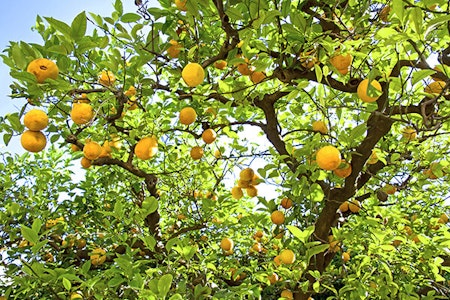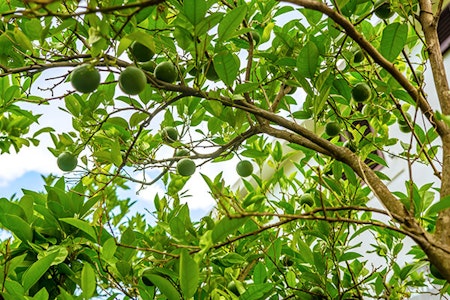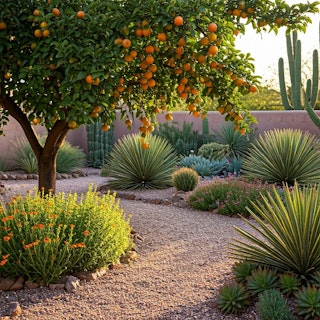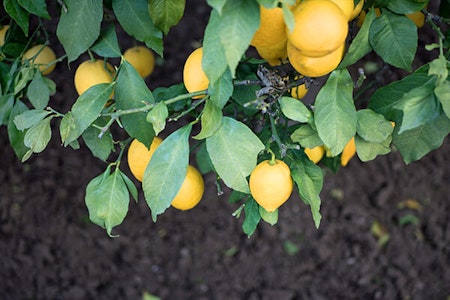 Be Inspired Blog - Arizona
Be Inspired Blog - Arizona

A Year in the Life of a Citrus Tree
Thinking about growing a citrus tree but not sure if you've got the green thumb for it? There are indeed a few different factors that go into growing and maintaining a healthy citrus tree, but if there was ever a place to try it, it's here in Arizona. Citrus trees are part of our history for a reason. Arizona's warm and dry climate makes for the absolute perfect conditions for growing citrus fruits.
But, in order to help your citrus tree truly thrive, care requirements like fertilizing, pruning and watering vary with the season. Check out this guide on the life of a citrus tree, and you'll be well on your way to enjoying delicious fruit and a beautiful tree for years to come!

Spring Citrus Tree Care
Your citrus tree has varying needs throughout the year. Spring is the optimal time to prune if needed. While some fruit trees thrive when pruned, it can actually be a bit of a source of stress for citrus trees. With that said, you do want to remove dead or diseased branches, and spring is the best time to do it. If they are trimmed between early March to about early May, you reduce the risk of damage from extreme temperatures.
Spring is also one of a few times throughout the year when you should pay particular attention to the task of fertilizing your citrus tree. While one generous application of fertilizer is needed in winter, during spring it’s a good idea to follow up with a lighter feeding in May. Be sure to use a fertilizer specifically formulated for citrus trees with high nitrogen (the first number in the NPK ratio). Additional soil amendments like humates, gypsum, or soil sulfur are especially beneficial for citrus trees—after all, they’re very heavy feeders! These amendments help to improve soil drainage and will make your fertilizer work even better, so your growing trees can soak up all that good stuff.
Citrus trees do best when heavily watered but infrequently. In the spring, you will want to water about once every 10 days. When you do water, it is best to do so slowly and deeply. This will help water reach a depth of about two feet into the soil around the tree.
Natural fruit drop generally occurs in the spring, so don’t be too alarmed if you see your citrus shedding some excess fruit around this time of year. With that said, this is also when common pests like aphids and thrips are at their peak. While not a huge threat to mature trees, aphids multiply quickly and can weaken a young tree. If you spot these pesky insects on your citrus tree, try spraying it down with water every day or two for about a week. You can also use organic insecticide formulas that are safe for use on edibles, or you can try biological pest control and release some hungry ladybugs.

Summertime Citrus Tree Needs
In Arizona, summer comes with some pretty hot, dry heat, which means your citrus tree may need a little bit more TLC. This is the time of year when you will want to increase the frequency of your watering schedule to about once a week, still remembering to water your citrus tree quite deeply and evenly. Don’t water the trunk directly, or this could cause gummosis—a very unappealing condition that causes trunk splitting and oozing.
Try to avoid pruning your citrus tree in the summer season if you can, as it can make it extra susceptible to damage from extreme temperatures. If you do need to remove, say, broken branches in the summer season, try to avoid removing too much of the canopy as the bark underneath may get sunburnt. If tender bark is exposed to the sun, you can use tree paint or tree wrap to protect it. Tree paints are a non-toxic, white colored formula that’s safe for use directly on your trees. It helps to keep your trees cool by reflecting the sunlight, instead of absorbing it like dark colors do.
We recommend fertilizing your citrus tree three times a year in February, May, and September, so it’s not something you need to pay a huge amount of attention to in the months of June and July. Instead, you may want to consider laying some mulch down. This helps to block the sun from heating up the ground and evaporating all the moisture around your tree’s roots. Spread an even layer of natural bark mulch all around the tree, being careful not to pile it up around the base. Spread it out about as far as the width of the tree canopy—this is typically a good size estimate of the root spread.
Citrus trees under drought or nutrient stress are more susceptible to scale and other plant infestations, so make sure that yours has its needs met throughout the year in terms of proper watering, fertilizing, and soil quality.
 Autumn Citrus Tree Care
Autumn Citrus Tree Care
Come the fall time, your citrus tree will hopefully have a bounty of fruit that is just getting ready to ripen. You will want to make your third fertilizer application by early September (around Labor Day) if you haven’t already. This will help your tree grow bigger fruit and may help new growth that should come once the weather cools a little more. Supplement your fall fertilizer application with a product like our Grow More Citrus Grower Blend, which contains essential micronutrients like iron, manganese, zinc, and copper.
A citrus tree’s watering needs in the fall are similar to those in the spring, so you can decrease your watering schedule back to about 10 days apart, continuing to ensure that you are watering deeply and evenly.
The fruit on your citrus trees will likely start showing some color as it is exposed to cooler overnight temperatures in September and October. If it has been damaged at all by extreme temperatures or the tree has not been watered enough, you might see some fruit split. Keep in mind, some citrus trees like Valencia and blood oranges ripen a little later in the season than others. Let them ripen on the tree—they won’t continue to ripen or get sweeter after picking!
While many folks insist that February and March are the best time to plant new citrus trees, you can also plant them in September when the temperatures have cooled down a bit. Just make sure to protect your young tree from cold temperatures over the winter by using tree wraps when necessary.

Citrus Tree Care In The Winter
Early ripening fruit may be ready to pick in November. As the year wraps up, continue to monitor the weather for potential freezing nights, picking fruit on the outside of the tree first as it is more likely to be exposed to the frost.
While the period that frost becomes a concern is smaller in Arizona than in other parts of the country, it’s definitely something to keep in mind when maintaining a citrus tree – particularly a young one! Consider having some form of frost protection like burlap or frost cloth on hand to protect your citrus tree during the months of December and January in particular.
Citrus trees are generally dormant throughout the winter months, but they do still need some water. You can also reduce your watering cycle to about once every three weeks or even once a month in the winter. You may notice your citrus tree shedding leaves, which just means they are getting ready for the next growing season. Your citrus tree fruit should all be ripe by January – happy picking!
In February, your citrus tree will be preparing to grow new buds, which means it is time to fertilize again. Remember to use a citrus tree fertilizer that’s high in nitrogen, and follow the instructions on the back of the package for safe, proper application. Mix in some amendments like humates, gypsum, and soil sulfur to increase effectiveness and improve drainage.
February is also the best time to prune your trees, because the heat gets too intense going into April and May. When pruning, avoid removing the lower branches as much as possible! These branches bear the most fruit.
February and March is actually the best time to plant new fruit trees, as the temperatures are comfortably mild. A piece of valuable advice for any prospective citrus grower: only plant what you need! You’ll have to harvest all that fruit in the winter, or else the old remaining fruits could attract bugs or rats. While you’ll often find a lot of the fruit drops naturally, some varieties like Valencia orange and grapefruit have fruits that really like to hang on! Plant a reasonably sized citrus tree for your property—dwarf trees are usually under 12 feet tall and easier to access for harvesting, while standard trees can reach up to 18–22 feet tall.
Citrus trees are a fantastic investment. With the right care, they will keep bearing fruit for you year after year. Whether you’re just preparing to take the leap into citrus tree ownership and have some more questions or you need some help diagnosing a problem, stop by one of our garden centers. Our trusted garden advisors would be happy to help!

